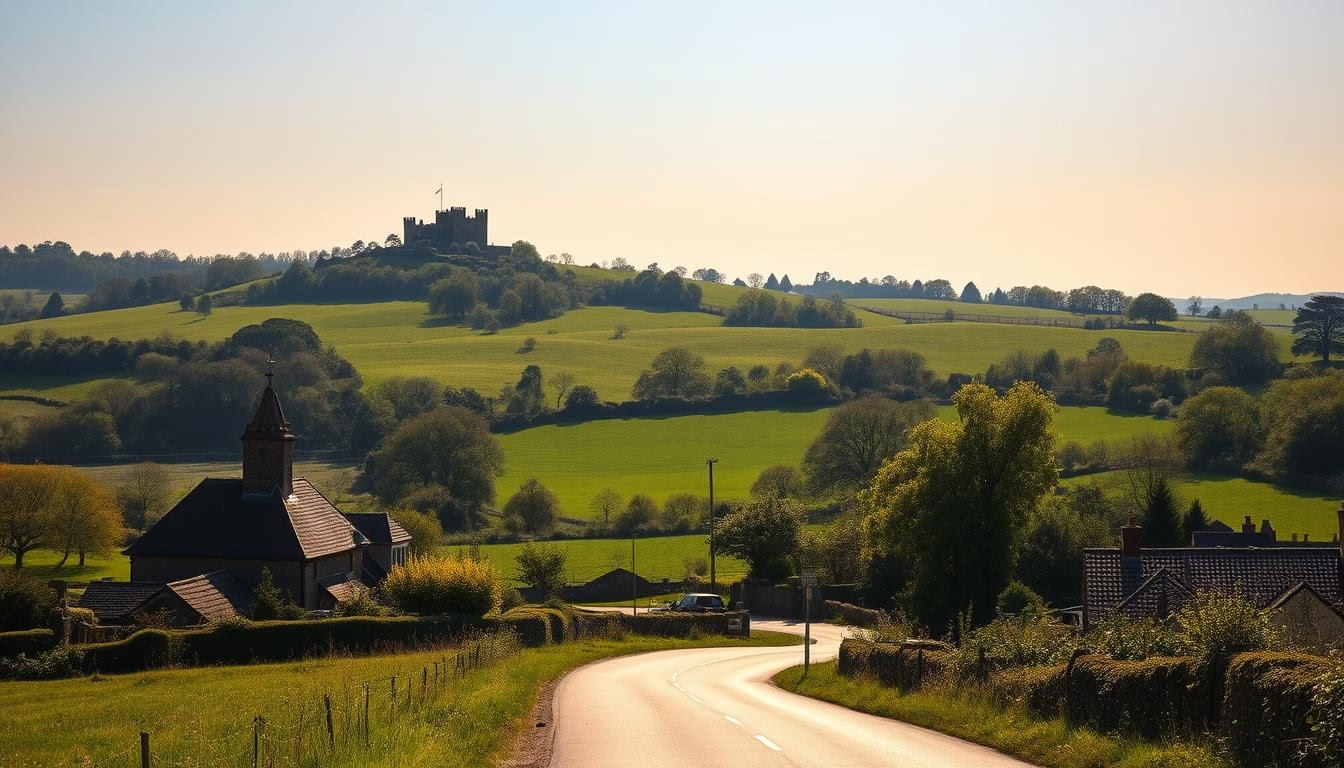Best Day Trips from London: Hidden Gems
Did you know over 20 historic sites listed in UNESCO’s World Heritage catalog sit less than an hour from London? The city’s central location makes it a springboard to explore centuries of culture, dramatic coastlines, and villages that look plucked from storybooks—all without renting a car.
Stepping beyond the capital reveals a different side of England. Quaint towns with cobblestone streets sit beside rolling hills dotted with sheep. Academic hubs like Oxford mix medieval architecture with modern energy, while seaside spots like Brighton buzz with colorful energy. Even royal landmarks like Windsor Castle feel worlds away from urban life.
Public transport connects it all seamlessly. Trains zip travelers to coastal cliffs in under 90 minutes, and buses wind through the Cotswolds’ honey-colored villages. These journeys aren’t just convenient—they’re gateways to immersive experiences. Imagine tasting fresh cider in Kent or walking Roman-era walls in Canterbury before sunset.
Key Takeaways
- London’s central position unlocks diverse destinations in under two hours
- Trains and buses eliminate the need for a rental car
- Options range from scholarly towns to coastal escapes
- Many locations hold UNESCO World Heritage status
- Trips reveal England’s cultural heritage beyond the city
Introduction: Discover Hidden Gems Beyond London
London’s energy is infectious, but even vibrant cities have quiet neighbors waiting to be discovered. Less than an hour away, rolling hills replace concrete jungles, and medieval market towns offer breathing room from urban crowds. These escapes aren’t just pretty backdrops—they’re living postcards of England’s rich heritage.
Why Venture Out of the City?
Constant stimulation wears thin. Studies show 72% of travelers feel more relaxed after spending time in nature. Swapping honking taxis for birdsong resets your mind. You’ll trade rushed meals for lazy pub lunches where servers know regulars by name.
An Overview of Accessible Day Trip Options
Variety defines these adventures. History buffs walk Roman roads, while foodies sample fresh oysters by the sea. Coastal trails and royal palaces sit within 90 minutes by train. With plenty of transport choices, you’ll spend less time commuting and more exploring.
Don’t worry about complex plans. Many routes run hourly, letting you linger at flower-filled villages or cliffside viewpoints. Whether you crave half-day museum hops or full coastal walks, the options adapt to your rhythm.
Exploring the best day trips from london by Public Transport
Navigating England’s transport network unlocks stress-free adventures beyond the capital. With frequent departures and straightforward routes, escaping the city’s hustle becomes effortless. Whether you prioritize speed or savings, options abound.
Train Routes and Timetable Tips
Major stations like Paddington and St Pancras serve as gateways to coastal towns and historic sites. Early bookings slash ticket prices—sometimes by 50%. Off-peak travel (after 9:30 AM) balances affordability with flexibility.

Popular routes to Canterbury or Brighton take under 90 minutes. Pro tip: Midweek tickets often cost less than weekend fares. Always check return timetables to avoid missing the last train.
Budget-Friendly Bus Options
Coaches provide wallet-friendly alternatives, with fares starting under £10. While journeys take longer, routes showcase countryside vistas you’d miss on faster trains. National Express services connect to popular destinations multiple times daily.
Consider these comparisons:
- Trains: Faster (30 mins – 2 hours) but pricier without advance bookings
- Buses: Takes around 25% longer but saves £15+ per ticket
- Both: Book 3+ weeks early for deals
Weekend warriors should note: Rural bus schedules often reduce service hours. Pack snacks and download offline maps for seamless navigation.
Historical Journeys: Oxford and Windsor Castle
Step into living history where medieval towers meet royal pageantry. Two iconic destinations—one shaped by scholars, the other by kings—offer immersive glimpses into England’s past.
Oxford’s Timeless Academic Charm
Oxford University predates Machu Picchu by centuries. Its honey-stone colleges birthed literary legends like Tolkien and Carroll. Wander through the circular Radcliffe Camera library—a masterpiece of architecture—or climb St Mary’s Church tower for city views.
Don’t miss quirky treasures: the Pitt Rivers Museum displays shrunken heads beside Victorian scientific tools. Refuel at The Grand Café, where England’s first coffeehouse opened in 1650. Punting on the River Cherwell lets you see Harry Potter filming locations from the water.
Royal Heritage at Windsor Castle
The world’s oldest occupied castle still hosts royal weddings. Marvel at Queen Mary’s Dolls’ House—a 1:12 scale palace with working elevators. St George’s Chapel holds 10 monarchs’ tombs, including Henry VIII.
Time your visit for the Changing of the Guard ceremony (select days at 11 AM). Trains from Paddington reach Windsor in 40 minutes—quicker than streaming a documentary about its 1,000-year history.
- Oxford transport: 1-hour train (£30+) or 2-hour bus (£13-18)
- Windsor tickets: £30 adults; book online to skip lines
- Pro tip: Combine both via a scenic Thames Valley route
Fairytale Villages and the Cotswolds Experience
Stone cottages glow like golden hour made permanent in England’s Cotswolds. This protected area spans 800 square miles of storybook landscapes, where sheep graze beneath honey-colored rooftops. It’s a place where time bends—centuries-old pubs sit beside family-run bakeries, and winding lanes lead to wildflower meadows.

Quaint Villages and Scenic Landscapes
Start in Burford, where a sloping high street reveals Tudor-era shops and cottages. Bourton-on-the-Water charms visitors with five stone bridges arching over the River Windrush. Don’t miss Bibury’s Arlington Row—17th-century weavers’ cottages that inspired Tolkien’s Middle-earth.
Key stops include:
- Stow-on-the-Wold: Ancient market square with artisanal shops
- Castle Combe: Cobblestone lanes without a single TV antenna
- Broadway Tower: Panoramic views from the second-highest point in the area
Traditional Tea Rooms and Local Crafts
Afternoon tea becomes art at Huffkins, serving Cotswold crumpets since 1890. Browse the Mad Hatter Bookshop’s crooked shelves or watch potters shape clay in Chipping Campden. Many shops sell wool blankets and lavender honey—perfect edible souvenirs.
For hassle-free exploring, consider Cotswolds tours from London covering multiple villages in a day. Independent travelers can take trains to Moreton-in-Marsh, then connect via local buses. Either way, leave room for spontaneous detours—like stumbling upon a village fête or hedgerow bursting with blackberries.
Seaside Escapes: Coastal Towns and Relaxation Spots
England’s coastline offers a refreshing contrast to city life, where salt air replaces traffic fumes. From lively piers to quiet fishing harbors, these coastal gems deliver classic seaside charm with distinct personalities. Pack your sunglasses—we’re exploring shores where history meets fresh-caught flavors.
Charming Seafront Towns and Piers
Brighton’s iconic pier juts into the sea like a glittering carnival. Watch street performers near the pebble beach, then explore the Royal Pavilion’s exotic domes. Prefer peace? Deal’s pastel houses and Saturday market feel frozen in time.
Folkestone surprises with rare sandy beaches and converted railway arches hosting indie galleries. Hastings mixes medieval drama with modern energy—ride Britain’s steepest funicular railway to its clifftop castle ruins. For pier enthusiasts, Southend-on-Sea holds the world record at 1.33 miles long.
Local Seafood, Fish and Chips, and Beachside Cafés
Nothing beats crispy fish chips wrapped in paper by the beach. Bankers Fish & Chips in Deal uses locally caught haddock, while Maggie’s in Folkestone serves theirs with samphire salt. Brighton’s The Salt Room offers upscale seafood platters overlooking the waves.
Beachside cafés like Hastings’ Goat Ledge serve flat whites with sea views. Many spots source ingredients daily from fishing boats—look for chalkboard menus highlighting the catch. End your day with sunset gelato on Southend’s endless pier.
Cultural & Culinary Adventures in Bath and Beyond
Bath’s golden stone buildings glow like honey under sunlight, a UNESCO World Heritage site where Roman engineering meets Georgian elegance. Just 80 minutes by train from London, this city rewards visitors with layered history and refined tastes. Whether you’re tracing ancient aqueducts or sipping tea in a 500-year-old bakery, every corner tells a story.
Historic Roman Baths and Georgian Architecture
Walk where Romans soaked in thermal springs 2,000 years ago. The Roman Baths complex still steams with mineral-rich waters—sample a sip at the Pump Room’s fountain. Look for the lone yellow door on Royal Crescent’s sweeping Georgian façade, a playful rebellion against uniform cream-colored entries.
Marvel at The Circus’s curved townhouses, their stone façades carved with mystical symbols and celestial motifs. Cross Pulteney Bridge to watch the Avon River cascade over its weir—this shop-lined bridge rivals Florence’s Ponte Vecchio for photogenic charm.
Authentic Local Cuisine and Afternoon Tea Experiences
Bath buns—sweet rolls studded with raisins—pair perfectly with a pot of Earl Grey at the Pump Room. For lunch, try The Circus Restaurant’s modern British dishes served in a 18th-century townhouse. Don’t miss Sally Lunn’s Historic Eating House, serving oversized buns since 1680.
Stroll cobbled streets to hidden courtyards like Abbey Green, where independent cheesemongers and chocolatiers tempt passersby. End your trip with a peaceful walk through Parade Gardens, where flowerbeds frame views of the river and Gothic abbey.
Pro tip: Trains run twice hourly from Paddington, but budget travelers can take National Express coaches for 60% less. Arrive before 10 AM to enjoy the Roman Baths without crowds.
Scenic Coastal Walks and Outdoor Activities
Feel the crunch of chalky paths beneath your boots as seabirds circle overhead—England’s coastlines transform walks into full-body experiences. These routes blend natural drama with stories etched into cliffs and coves. Pack sturdy shoes and curiosity.
Walking the White Cliffs of Dover
The iconic cliffs offer panoramic views stretching to France on clear days. Trains from London take around 80 minutes, followed by a quick taxi ride. Start at the visitor center for the South Foreland Walk—a 2-mile trail revealing wartime tunnels and wildflower meadows.
Pause at Mrs Knott’s Tearoom near the lighthouse for scones with clotted cream. History buffs love exploring Fan Bay’s WWII shelters carved into the chalk. Return via St Margaret’s Bay for sunset views over fishing boats.
Wildlife and Nature Trails Along the Coast
Look for peregrine falcons diving above Dover Castle or rare orchids blooming in spring. The coastal way teems with life—seals often bask on distant rocks. Time your walk for low tide to spot crabs in tidal pools.
Coaches take 3+ hours but save money. Either way, allow 4 hours to fully enjoy the area. Bring layers—sea breezes chill quickly even on sunny days. Pro tip: Weekday visits mean fewer crowds at photo hotspots.






